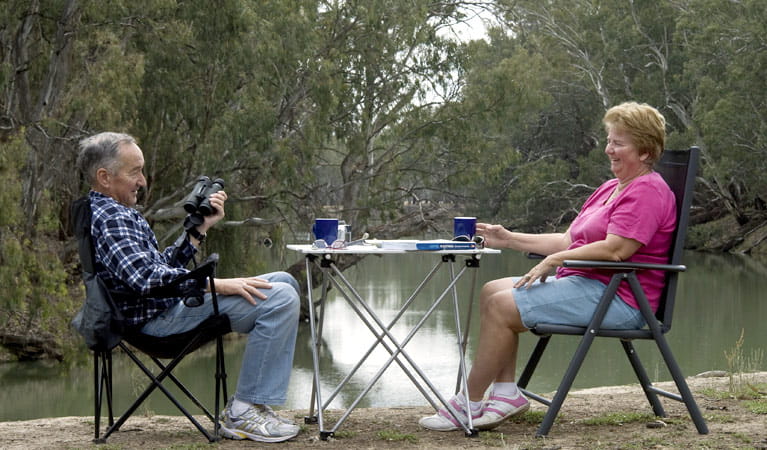Mamanga campground
Yanga National Park
Overview
Camp at Mamanga for fishing, swimming and kayaking. This free campground, by the Murrumbidgee River, features campsites for tents, trailers, caravans and motor homes.
| Number of campsites | 14 |
|---|---|
| Camping type | Tent, Camper trailer site, Caravan site, Camping beside my vehicle |
| Facilities | Picnic tables, barbecue facilities, toilets |
| What to bring | Drinking water, cooking water, firewood, toilet paper |
| Price | There are no camping fees at this campground but a $6 booking fee applies. |
| Group bookings | Bookings for up to 5 sites and 20 people can be made online. School groups and commercial tour operators can submit a group booking enquiry form. |
| Please note | The campground is generally level, so it offers moderate access for less-mobile visitors. |
Camp on the banks of Murrumbidgee River at Mamanga campground, located near Balranald in Yanga National Park. A large, secluded area, Mamanga campground features two sections – one for tent camping and another more open section for caravans and motor homes.
Set up your campsite among the surrounding native bushland and spot animals and birds living in striking river red gums and black box eucalypts. Take a walk along the floodplain and look closely at the trees, many are bark-scarred, and show evidence of the area’s Aboriginal heritage.
Go fishing, swimming, kayaking or canoeing in the river, try mountain biking to one of the park’s great picnic spots or take a self-guided tour through nearby Yanga Woolshed.
Map
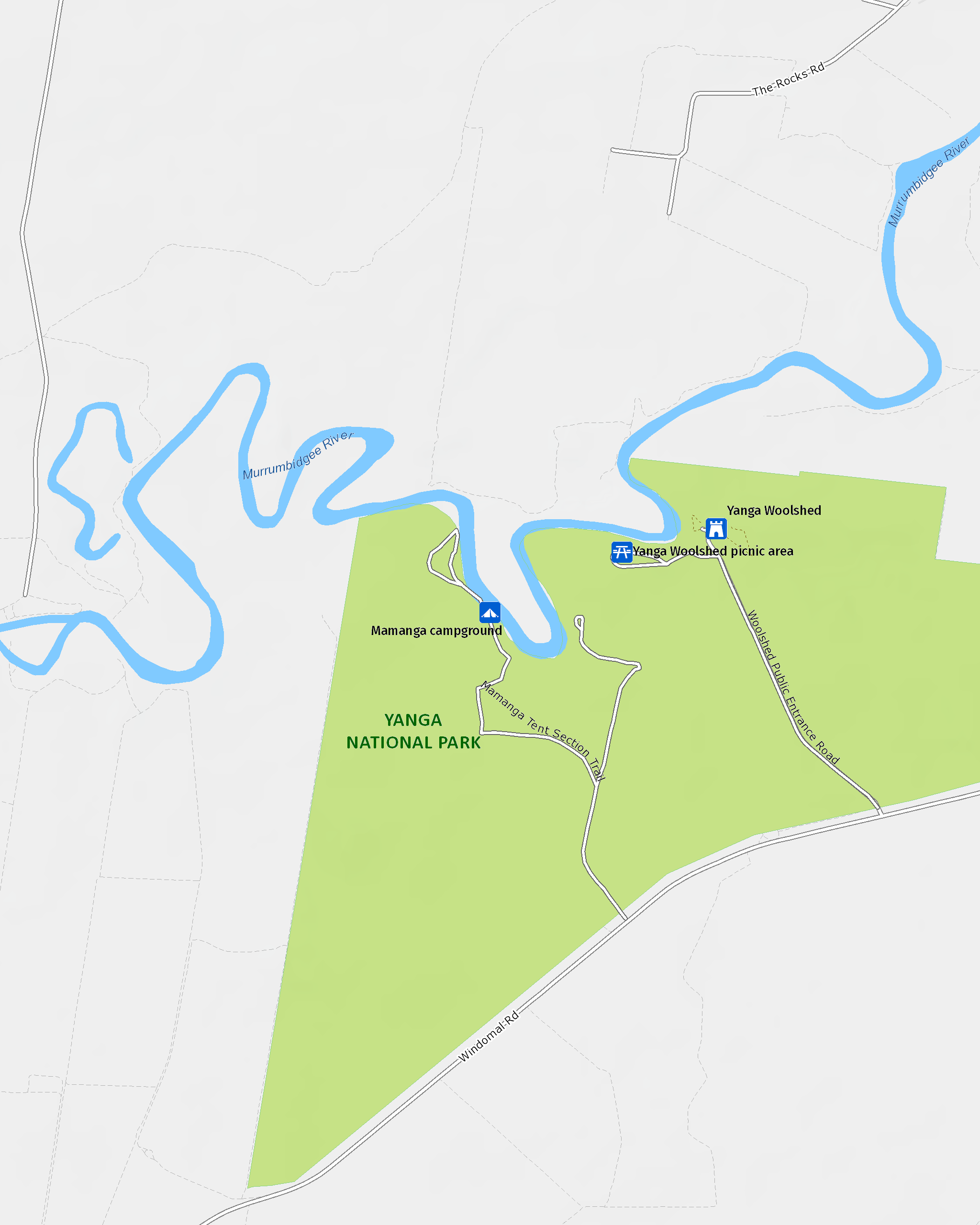
Map legend

Local alerts
For the latest updates on fires, closures and other alerts in this area, see https://www.nationalparks.nsw.gov.au/camping-and-accommodation/campgrounds/mamanga-campground/local-alerts
Bookings
- National Parks Contact Centre
- 7am to 7pm daily
- 1300 072 757 (13000 PARKS) for the cost of a local call within Australia excluding mobiles
- parks.info@environment.nsw.gov.au
Operated by
- Yanga National Park office
- 8.30am to 4.30pm daily.
- 03 5020 1764
- npws.lowerdarling@environment.nsw.gov.au
- 38773 Sturt Highway, Balranald NSW 2715
Park info
- in Yanga National Park in the Murray-Riverina region
Yanga National Park is open Sunrise to Sunset but may have to close at times due to poor weather or fire danger.
Yanga Homestead Precinct is open 8.30am - 4.30pm.
Visitor info
All the practical information you need to know about Mamanga campground .
Getting there and parking
Mamanga campgound is located in the Woolshed precinct of Yanga National Park. To get there:
- From Balranald, travel east along Sturt Highway for 2km.
- Turn right onto Windomal Road
- Continue for approximately 4.2km before turning right at the sign to Mamanga campground
- The turn-off is 1.2km past the turn-off to Yanga Woolshed.
Road quality
- Unsealed roads
Vehicle access
- 2WD vehicles
Weather restrictions
- Dry weather only
Parking
Parking is available at your campsite.
Best times to visit
The locals will tell you it can get pretty hot out this way, so you may wish to time your visit to avoid the summer heat. Temperatures during autumn, winter and spring are more moderate - just be sure to check the forecast as roads can become inaccessible in wet weather.
Spring
A great time to see the woodland birds - be sure to bring your binoculars.
Facilities
- Water is not available at this campground.
- Park staff endeavour to supply some firewood at a collection point but there is a limited supply.
Toilets
- Non-flush toilets
Picnic tables
Barbecue facilities
- Wood barbecues
Step-free access
The campground is flat and step-free, but there are no pathways. You'll need to cross over hard-packed ground and grass to reach the facilities.
Maps and downloads
Accessibility
Disability access level - medium
Mamanga campground is flat and step-free, but there are no pathways. You'll need to cross over a mixture of hard-packed ground and grass to reach the facilities.
The campground has accessible and ambulant toilets.
Permitted
Camp fires and solid fuel burners
Whether you're pitching your tent on the coast or up on the mountains, there are many things to consider when camping in NSW national parks. Find out how to stay safe when camping.
If you’re visiting between April and September (outside the fire danger period) you can light a campfire in one of the fireplaces provided
Prohibited
Camp fires and solid fuel burners
A fire ban applies in Yanga National Park during the fire danger period (usually October – March depending on seasonal fire conditions). Please do not light campfires or barbecues which use solid fuel during this period
Pets
Pets and domestic animals (other than certified assistance animals) are not permitted. Find out which regional parks allow dog walking and see the pets in parks policy for more information.
Smoking
NSW national parks are no smoking areas.
Learn more
Mamanga campground is in Yanga National Park. Here are just some of the reasons why this park is special:
A pioneering history
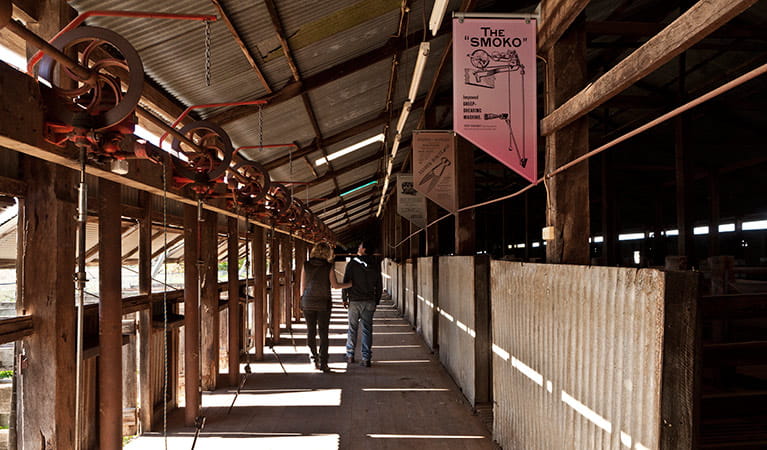
Some of the country's renowned early explorers passed through this area, and you have the opportunity to retrace their steps. Explorers included John Oxley in 1817, Charles Sturt in 1830, Major Thomas Mitchell in 1836 and Burke and Wills in 1860. Visit nearby Balranald to see where Bourke and Wills' party crossed the Murrumbidgee by the Mayall Street punt, then camped by the river in front of Balranald Inn.
- Yanga Woolshed Explore Yanga Woolshed in Yanga National Park. When constructed in the late 1800s, the woolshed was the Riverina’s largest. It offers an insight into Australia’s pastoral history.
- Yanga Woolshed picnic area Located in Yanga National Park, near Balranald in the Riverina, Yanga Woolshed picnic area is an excellent place for a barbecue or spot of fishing on the Murrumbidgee.
A remarkable landscape
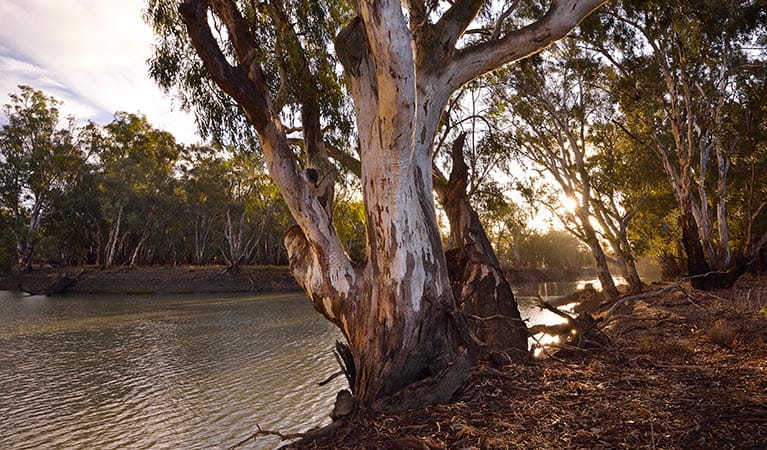
Yanga National Park is blessed with 170km of Murrumbidgee River frontage. The river is great for canoeing or swimming, and its banks provide excellent fishing and camping spots. On your visit, you'll notice the landscape's unique contrast of black and red country. Vegetation on its black soil floodplains comprises river red gum forest and swampland, while its red soil varies from grass to saltbush to woodlands. Come and spot the differences yourself.
- Regatta Beach picnic area Enjoy swimming, boating, birdwatching and paddling in the tranquil lakeside waters of picturesque Regatta Beach picnic area in Yanga National Park, near Balranald.
Rich in Aboriginal culture
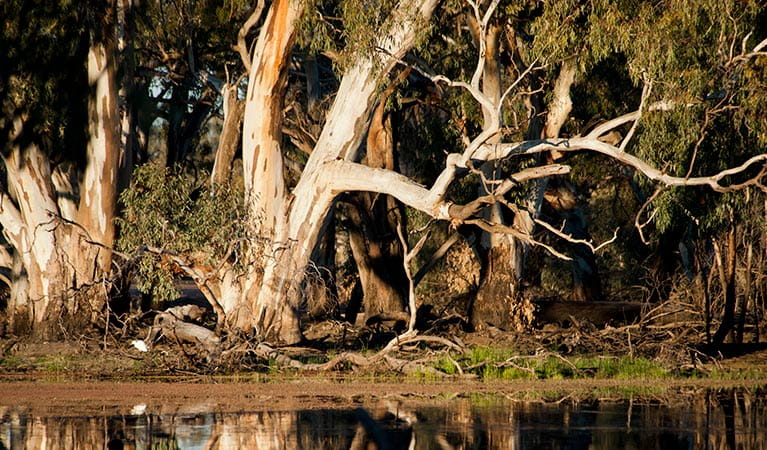
Yanga National Park has a rich Aboriginal history; the park provided resources including waterbirds, fish, and yabbies as well as shelter and medicine. Look closely at the trees in the floodplain where you're visiting – many bear the bark-stripping scars from canoe-making. Today, local Aboriginal people remain connected with Yanga National Park through employment or community involvement.
- Yanga Lake viewing deck Yanga Lake viewing deck offers spectacular birdwatching and scenic wetland views in Yanga National Park, near Balranald.
Unbeatable for birdwatchers
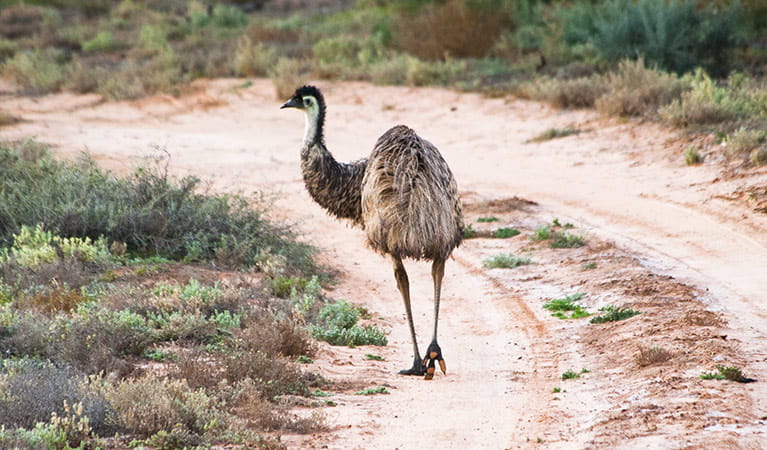
A large number of migratory birds rely on the Yanga National Park red gum wetlands. The park is a great place to see egrets, herons, spoonbills and glossy ibis using the wetlands as a resting, foraging and breeding ground. Walk to the bird hide at Yanga Lake to see great crested grebes and sea eagles. The park is also home to the endangered southern bell frog. This frog's calls' are said to resemble a distant motorbike – listen carefully to see if you can hear it.
- Yanga Lake paddle Kayak Yanga Lake for an outback experience like no other. Wonder at the vast sky reflected in 1200ha of water, and spot wildlife and birds drawn to the wetlands in Yanga National Park.
- Yanga Lake Red Gum bird hide All the family will enjoy spectacular birdwatching and scenic views at Yanga Lake Red Gum bird hide in Yanga National Park near Balranald.
- Yanga Lake walking track Short yet rewarding, Yanga Lake walking track is a family friendly lakeside walk offering scenic wetlands views and spectacular birdwatching in Yanga National Park.
Plants and animals protected in this park
Animals
-

Southern boobook (Ninox novaeseelandiae)
The southern boobook, also known as the mopoke, is the smallest and most common native owl in Australia. With a musical 'boo-book' call that echoes through forests and woodlands, the southern boobook is a great one to look out for while bird watching.
-

Common ringtail possum (Pseudocheirus peregrinus)
Commonly found in forests, woodlands and leafy gardens across eastern NSW, the Australian ringtail possum is a tree-dwelling marsupial. With a powerful tail perfectly adapted to grasp objects, it forages in trees for eucalypt leaves, flowers and fruit.
-
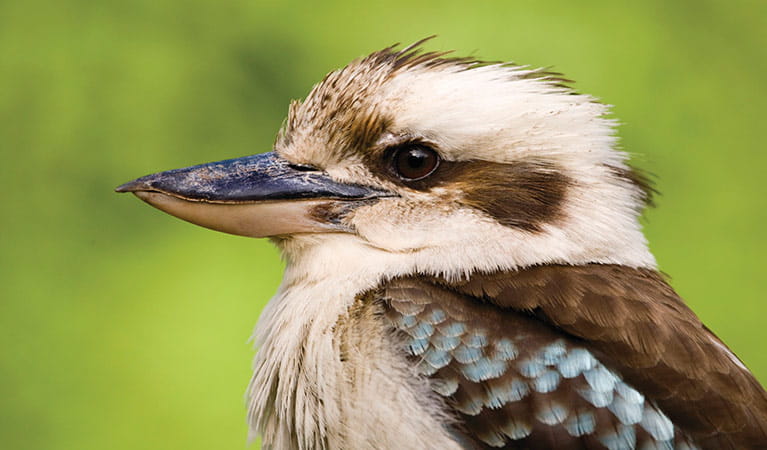
Kookaburra (Dacelo novaeguineae)
Of the 2 species of kookaburra found in Australia, the laughing kookaburra is the best-known and the largest of the native kingfishers. With its distinctive riotous call, the laughing kookaburra is commonly heard in open woodlands and forests throughout NSW national parks, making these ideal spots for bird watching.
Plants
-
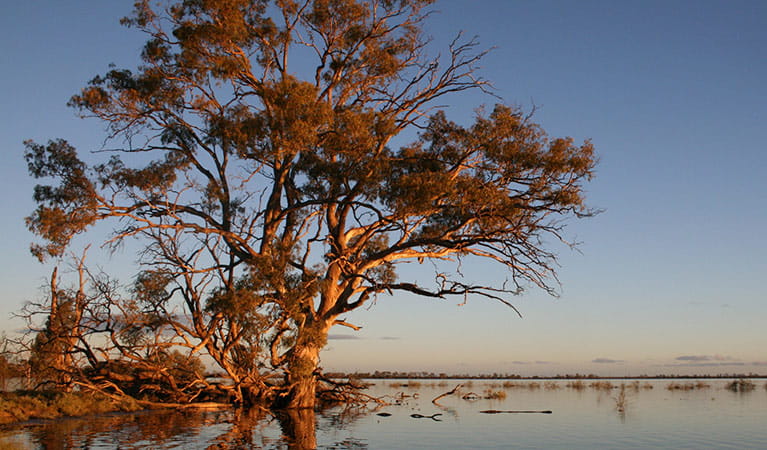
River red gum (Eucalpytus camaldulensis)
Australian native plants, majestic river red gum trees are widespread across Australian inland river systems. The river red gum is a dominant tree species of the Murray-Darling basin which spans NSW, Queensland and Victoria. This iconic native eucalypt grows to a height of 30m and is thought to have a lifespan up to 500-1000 years.
-
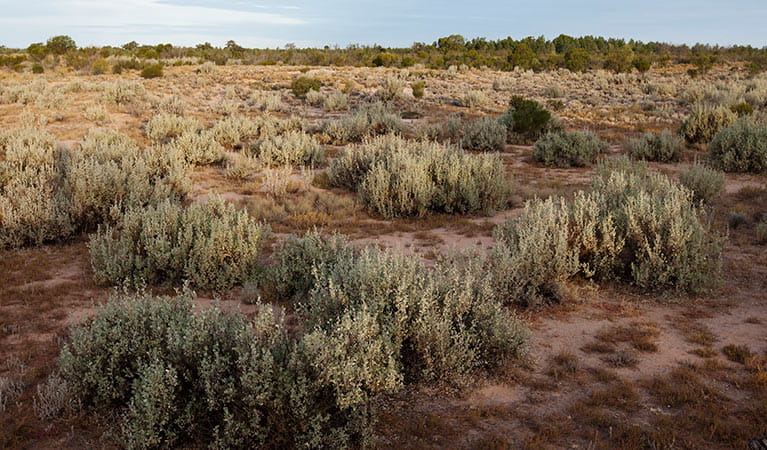
Saltbush (Atriplex nummularia)
A hardy Australian native plant, the saltbush is a small spreading shrub that can withstand dry salty soils such as those found in the desert plains of western NSW. It is grey-white in colour and has small spear-shaped succulent leaves. It flowers from December to April.

